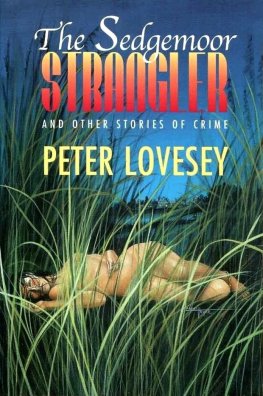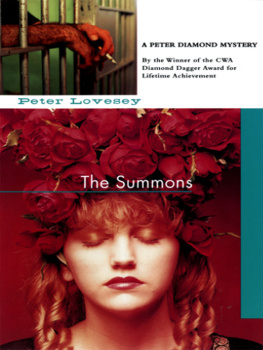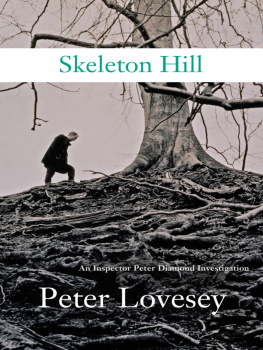Peter Lovesey
The Sedgemoor Strangler and Other Stories of Crime
Copyright by Peter Lovesey 2001
The Sedgemoor Strangler was first published in Criminal Records (Orion) 2000; The Perfectionist in The Strand Magazine, 2000; Interior, With Corpse in Scenes of the Crime (Severn House) 2000; Dr Death in Crime Through Time III (Berkley) 2000; The Four Wise Men in More Holmes for the Holidays (Berkley) 1999; Away with the Fairies in Malice Domestic 10 (Avon) 2001; Showmen in Past Poisons (Headline) 1998; The Word of a Lady in Ellery Queens Mystery Magazine, 2000; Star Struck in Death by Horoscope (Carroll & Graf) 2001; The Amorous Corpse in The Mammoth Book of Locked Room Mysteries and Impossible Crimes (Robinson) 2000; The Kiss of Death in The Kiss of Death (Gift edition from Crippen & Landru Publishers) 2000; The Stalker in this edition; Ape in Mary Higgins Clark Mystery Magazine, 1998; The Usual Table in The Mysterious Press Anniversary Anthology (Mysterious Press) 2001; The Problem of Stateroom 10 in Murder Through the Ages (Headline) 2000; Murdering Max in Ellery Queens Mystery Magazine, 2001.
If there is a theme to this collection it is the idea of the perfect murder. As Jacques Futrelle, the creator of The Thinking Machine, explains in The Problem of Stateroom 10, crime writers deal in murders that are imperfect. Ingenious, maybe, but imperfect. The pleasure comes from setting up a mystery, or a challenge, that almost succeeds. Presumably in real life perfect murders are committed and we never hear about them.
This is not quite the same as unsolved murders, such as the Jack the Ripper crimes. The incompetence of the police ensured that Jack went unpunished, rather than any ingenuity on his part. His awe-inspiring name became a by-word and showed a touch of genius, but may have been invented by one of the scores of attention-seekers who wrote letters at the time.
So a satisfying story will intrigue the reader with a crime that aspires to perfection and almost succeeds. It may be the sort of challenge issued to The Perfectionist, or young Finch, in The Problem of Stateroom 10. Or it can take the form of an impossible event, like The Amorous Corpse. Or maybe a serial murderer must be unmasked before he strikes again, as in Dr Death, and The Sedgemoor Strangler.
Prepare to meet some famous and infamous figures from the world of crime. Sherlock Holmes and Dr Watson investigate The Four Wise Men; and, in Showmen, William Hare, the body-snatcher, explains what it means to get away with murder.
In almost all of the stories there are decent, law-abiding people plunged into events outside their normal experience. It is my hope that you, my reader, will want to share in the shocks and surprises. You never know when it may come in useful.
PETER LOVESEY
Listen.
What is it?
If there was a sound, it was not obvious. All Emma could catch was a scent, the mock orange drifting across the lane from one of the cottage gardens. On this warm June night, hidden among the withies with her dreamboat of a man, she was thinking only of romance.
Kiss me.
No. Listen. Can you hear a rustling sound?
Emma was not minded to listen. She curved her hand around his neck to draw his face closer to hers.
He resisted, bracing his shoulders. Its all around us. What is it insects?
With a wriggle of her hips, she let him know she wasnt lying naked on the ground to discuss the wildlife of Somerset.
Just listen.
Theres nothing, she murmured. Its only the wind, I expect. Come on, lover.
He was not her lover yet, and he would not relax. Wind? Theres no wind.
She hesitated. Until this minute, he had seemed so confident, so appreciative of her. She really wanted him. Their first passionate coupling would be ruined if she lost her patience.
He insisted, There isnt a breath of wind tonight.
Then it must be the withies growing.
The what?
All around us.
This was true. On a hot day on Sedgemoor, a crop of these fine willow wands may get taller by two or three inches. After dark the process continues, more slowly, yet, in the still of the night, it is audible. The rustle he had heard was the sound of growth itself. Months back, in winter, the withies had been pruned to the stump. Now taller than a mans reach, with graceful foliage, they testified to the richness of the earth that nourished them. This mud that Emma was lying in call it earth, silt or topsoil was the lifegiver. All you had to do was push a willow-cutting into the ground and it would sprout roots and grow.
The crop screened the couple from the row of stone cottages across the lane. A withy bed is not the ideal place to lie down and make love, but you have to take what you can find in the flat landscape of the moor. These two had gone to some trouble to avoid being seen. His car was parked outside the village, up a track leading to a field. They had approached from around the back of the crop, away from prying eyes, regardless that the fading light would shortly bring them privacy anyway. But there: lovers are not good planners. Persevering, stepping with care to avoid the nettles, eventually they had found this space between the tall willow wands.
The secretiveness was more at his insistence than Emmas. Nobody would recognise her. She was not from withy-growing people. Her parents were middle-aged hippies who ran one of the many alternative shops in Glastonbury, selling trinkets and jewellery with so-called occult properties. Emma had rebelled against all that in her early teens, found work pulling pints in a pub for better money per week than her parents made in a month. She made new friends there. It was such a treat to mix with people who earned enough to take you out for a meal and buy you the occasional present.
By now she was becoming just a little impatient with her partner. Is there a problem? she asked, but trying to put some concern into her voice. Havent you done it outdoors before?
Keep your voice down.
Nobodys about, and if they were, it wouldnt matter. They dont know who we are.
Reassured, or goaded into action, he turned on his side and drew her towards him, slid his hand down her back and over the rise of her hip and announced, Your backside is covered in muck.
She giggled. He was no better at sweet-talk than she was. She squirmed closer, presenting all of her bottom for him to pass his hand over, supposedly to brush off the specks of earth. The undressing had been one-sided up to now. His own rump was still enclosed in denim and whatever he wore underneath. Still, Emma didnt mind if it led to a result. All blokes were different. This one definitely needed coaxing.
She located his belt and unfastened it. He tensed. She freed the top button of his jeans.
This man was not much of a stud. He came prematurely, when Emma was thinking of other things. Asking herself Is that it? she lay in the mud and looked at the stars.
No, that was not it. Presently she felt his hands around her throat.
The tourist board calls this place the Wetlands or the Levels; to the inhabitants it was, is now and ever shall be Sedgemoor. It needs no glamorizing. It has more of legend, mystery and tragedy than anywhere else in England. If you have heard of Sedgemoor, you probably connect it with the bloody battle that was fought there in 1685, when the Duke of Monmouths pitchfork rebellion was crushed by the Kings Army. Sedgemoor as the locals speak of it ranges far more widely than the battlefield. It is the entire tract of marshland bounded by Bridgwater Bay in the west and the Mendip and Quantock Hills inland. When the Ice Age ended and the waters rose, the region became a stretch of sea, with a few tiny islands. Ultimately the sea receded, drew with it a mass of clay and left a ridge that formed a natural dyke. Sedgemoor was enclosed, a vast floodplain waterlogged each winter by rivers that overflowed. Flooding may devastate, but it also spreads deposits of fertile silt across the earth. In times relatively modern, drainage systems were introduced, and with them cattle, cider-orchards and withy beds.










